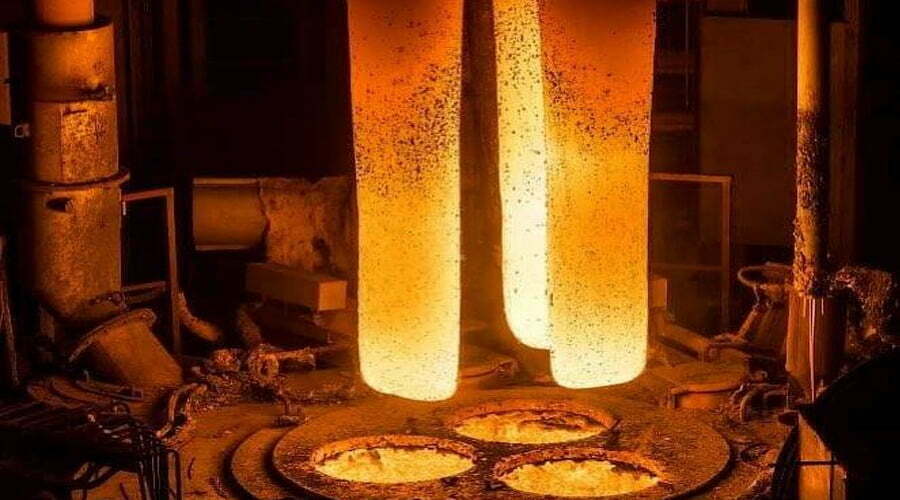Submerged arc furnace electrodes are divided into three types: carbon electrodes, graphite electrodes and self-baking electrodes according to their uses and production processes.
In submerged arc furnaces, self-baking electrodes are mainly used because of their low cost, but when producing ferroalloy products with lower carbon content, such as industrial silicon, graphite electrodes are required. The differences between self-baking electrodes, carbon electrodes and graphite electrodes are as follows:
Submerged arc furnace electrodes
1.The carbon electrode is made of low-ash anthracite, metallurgical coke, pitch coke and petroleum coke as raw materials, and is composed of a certain proportion and particle size. When mixing, add binder pitch and tar, and stir evenly at a suitable temperature. , and then slowly roasted in a roaster.
2.Graphite electrode is made of carbon electrode with petroleum coke and pitch coke as raw materials, and then placed in a graphitized resistance furnace with a temperature of 2000~2500 ℃, and the graphite electrode is obtained by graphitization.
3.The self-baking electrode uses anthracite, coke, pitch and tar as raw materials to make electrode paste at a certain temperature, and then put the electrode paste into the electrode shell that has been installed on the electric furnace. During the production process of the electric furnace, when the electric current passes through The Joule heat generated and the heat transfer in the furnace are self-sintering and coking. This kind of electrode can be used continuously, and it can be sintered and formed at the same time as long as it is used, and it can be fired into a self-baking electrode with a large diameter.
The self-baking electrode has a simple manufacturing process and low cost, and is widely used in the production of ferroalloys. It’s usually used to produce ferrosilicon, silicon-chromium alloy, silicon-manganese alloy, high carbon ferromanganese, medium and low carbon ferromanganese, high carbon ferrochromium, medium and low carbon ferrochromium, silicon calcium alloy, ferrotungsten, etc.
Self-baking electrodes are easy to carbonize the alloy, and the iron sheet of the electrode shell is also easy to bring iron into the alloy, so the production of iron alloys and pure metals with very low carbon content, such as micro-carbon ferrochromium, industrial silicon, silicon-aluminum alloy, metal manganese, etc., use carbon plain electrode or graphite electrode.
Submerged Arc Furnace Electrodes Process & Operation
Today, let’s first understand the details of the self-cultivation electrode
Sintering principle of self-baking electrodes
Heat source:
(1) Conduction heat of the electrode itself
(2) Heat radiated upward from the temperature in the electric furnace
(3) Resistive heat generated when current passes through the electrodes
Sintering process:
(1) The temperature rises from room temperature to 200°C, and the electrode paste gradually melts from a lump to a molten state.
Moisture and low-boiling components begin to evaporate.
(2) The temperature rises from 200°C to 600°C, the binder begins to volatilize and decompose, and the electrode paste gradually changes from a molten state to a solid state.
(3) The temperature rises from 600°C to 800°C, and the residual volatiles continue to be discharged.
After 4 to 8 hours, the electrode roasting basically ends when the electrode comes out of the copper tile.
Electrode hard break
Reason:
(1) The ash content of the electrode paste is too high, there are many impurities, the sintering quality is not good, and the strength is not enough.
(2) There is a lot of dust in the electrode shell, which makes the two layers of electrode paste appear as an isolation layer.
(3) A large amount of air leaks into the high temperature area of the furnace, which seriously oxidizes and thins the electrode.
(4) The electrode is not pressed and released for a long time.
(5) After the furnace has been shut down for a long time, and the electrode heating speed is too fast during the power transmission process, the electrodes above and below the material will generate electrode stress due to the asynchronous cooling speed and heating speed, causing the electrodes to crack and harden break.
Whether the submerged arc furnace electrodes is a carbon electrode, a graphite electrode or a self-cultivation electrode, it needs to be selected according to the specific requirements of the furnace.
For more information about SAF, EAF, LF and other melting furnaces, please pay attention to our website.
Any questions or needs, please feel free to contact us at any time.

